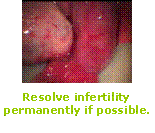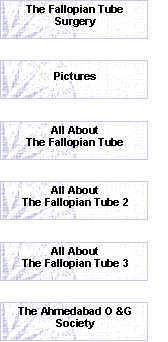|
tubal pathology. First, these techniques may be indicated in selected cases of distal tubal pathology. In these cases, the operative procedures carried out by laparoscopy are similar to the microsurgical ones. Second, the laparoscopic surgery may be indicated for sterilization reversal if the anastomosis is isthmic-isthmic, isthmic-ampullary or ampullary-ampullary. Third, on the contrary, laparoscopic surgery is not recommended for organic proximal occlusion. Microsurgery by laparotomy remains the gold standard. Laparoscopic tubo-cornual anastomosis is still now too difficult to perform using laparoscopy due to the usual bleeding after partial cornual resection and to the depth of the site for the suture. If a salpingectomy is needed, the laparoscopic technique is recommended.
MICROSURGERY
With the current success rates of assisted conception treatments many practitioners now believe that tubal surgery is an obsolete procedure, and can be easily dispensed with. In well selected patients, tubal microsurgery can still give results equal or some times superior to those achieved by assisted reproduction techniques. Walz in 1959 used the microscope for tubal repair for the first time. Others used delicate electromicrosurgery and magnification (loupes) in the treatment of hydrosalpinges. Paterson & Wood (1974) in Australia and Winston & McClure-Browne (1974) in England adapted their research techniques to humans using high magnification with a microscope. After many arguments tubal microsurgery then became well established and as routine procedure for tubal tubal surgery. Microsurgery has consistently proved to give better results than macrosurgery. The technique involves not only the use of a microscope, but also a change in the philosophy of surgical technique. This approach is based on careful handling of tissues, the use of magnification, the use of fine and, in general, non-reabsorbable suture material and the peritonealisation of raw areas. A major problem of tubal surgery used to be post-operative adhesion formation. This changed with the use of a microsurgical approach. A lot has been said about the use of coadjuvants, such as steroids, dextran 5%, large quantities of dextrose solution and artificial membranes in the prevention of adhesion formation and there are many publications on these. But no coadjuvant can replace or help bad surgical technique. Selection of patients, as with any other type of treatment in medicine, is very important in order to obtain good results. The assessment of |



|
To contact me: |